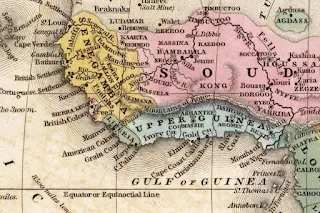Mountains of Kong: Map Makers Got This Totally Wrong
If you are age 46 and older you studied the fictional West African Mountains of Kong in your school textbooks.
The Mountains of Kong appeared on print maps for 225 years between 1798 and 1995.
European explorers and mapmakers made the world believe in the existence of a mountain range called the Mountains of Kong in West Africa. The fictional mountain range was thought to stretch through present-day countries such as Guinea, Mali, Côte d'Ivoire, Burkina Faso, and Ghana.
Different maps and cartographic representations varied in depicting the Mountains of Kong. Some portrayed them as an extensive range stretching across a large part of West Africa, while others depicted them as a smaller range confined to specific regions.
However, it was later discovered that the Mountains of Kong were purely fictional and did not actually exist. The origin of this mistake can be traced back to a French cartographer, Philippe Vandermaelen. In the early 1800s, Vandermaelen created a world atlas and included the Mountains of Kong as a prominent feature on his maps.
He believed this information as his maps were based on reports and narratives from explorers and travelers who did not actually visit the region.
Map makers often heavily relied on reports and narratives from explorers and travelers to gather information about uncharted regions.
These explorers may have heard stories or encountered local legends referring to mountainous areas, which they then mistakenly associated with a continuous mountain range known as the Mountains of Kong.
Philippe Vandermaelen was a French cartographer primarily known for creating the first world atlas in a large-scale format. Published between 1827 and 1837, Vandermaelen's atlas consisted of approximately 380 sheets of maps and covered the entire world.
Vandermaelen's maps were highly trusted however, the inclusion of the fictional Mountains of Kong in West Africa, which persisted in subsequent editions of his maps contributed to the misconception of their existence.
The idea of the Mountains of Kong persisted because of this, and subsequent mapmakers and explorers continued to include them on their maps.
However, as more extensive explorations of West Africa took place, it became evident that the Mountains of Kong were nonexistent because the actual geography of the region did not align with the depiction of a continuous mountain range.
The mistake regarding the Mountains of Kong on maps was eventually caught through further explorations and surveys conducted in West Africa. As more extensive expeditions took place, explorers began to realize that the depiction of a continuous mountain range known as the Mountains of Kong did not align with the actual geography of the region.
Explorers and geographers, such as Heinrich Barth, René Caillié, and Alexander von Humboldt, made significant contributions to understanding West African geography.
Their explorations provided more accurate information about the landscape, including the absence of the Mountains of Kong as depicted on earlier maps. However, Goode's World Atlas did not get the memo.
In 1995, Goode's World Atlas, produced by the Rand McNally & Company, included the Mountains of Kong; the error was later discovered, and subsequent editions of the atlas corrected the omission of the fictional mountain range. However, reference books and encyclopedias referenced the Mountains of Kong throughout the 19th and 20th centuries.
If you are ages 46 and older, it is highly possible that during your school years, you encountered references to the fictional Mountains of Kong in various forms of media, including reference books, encyclopedias, or even within the pages of a World Atlas. So, if you can explore reference materials from that era, you might come across this intriguing but ultimately nonexistent mountain range.
It is now understood that the "discovery" of the Mountains of Kong was a significant error in mapmaking and an example of how lies can persist Through copying material that is incorrect and further exploration and knowledge correct them.
Today, the Mountains of Kong serve as a reminder of the importance of verifying information and relying on accurate sources when studying geographical subjects.
So remember, in West Africa, there are no recognized mountain ranges called the Mountains of Kong or elsewhere on the African continent. Collaborations between cartographers, surveyors, geographers, and other experts help maintain the highest standards in map production.
If you notice the names on the map above, then here is more information:







